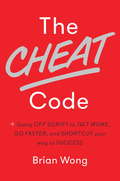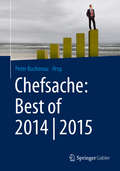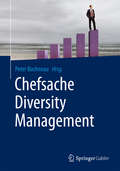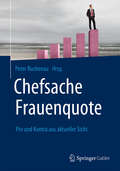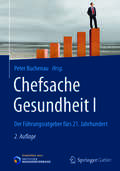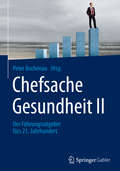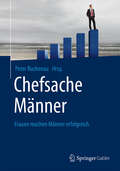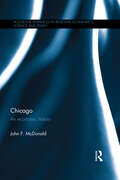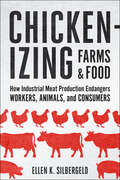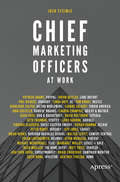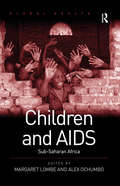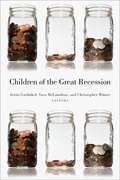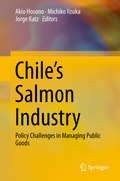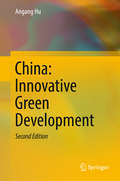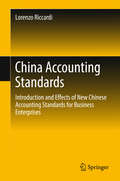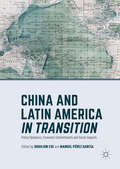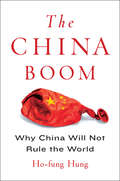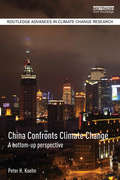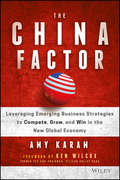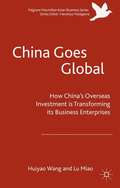- Table View
- List View
The Cheat Code: Going Off Script to Get More, Go Faster, and Shortcut Your Way to Success
by Brian WongHave you ever noticed that there are certain people who seem to get ahead just a bit faster than everyone else? You know, the types who always seem to be a bit ahead of the curve, to get noticed a bit more, and to achieve their goals a bit more quickly than the rest of the pack? And have you ever noticed how much this small edge can matter, and the outsized impact it can have on the trajectory of their careers? Twenty-four year old entrepreneur Brian Wong is one of these people, having graduated from college by age 18, having raised $24 million in venture capital to start his own company before he turned 25, and having grown that company into a global mobile advertising giant in just 4 years. His secret? The Cheat Code. Wong believes that most people -- even creative people -- have a tendency to follow a script; to do things the way others do them simply because that way works. But therein lies the secret at the heart of the Cheat Code: anyone can easily shortcut his or her way to success, simply by going slightly off script; by doing things just a little differently from everyone else. Here, Wong unlocks the power of the Cheat Code through 71 bite-sized and virtually effortless short-cuts to get a leg up on the competition, garner attention for ourselves and our ideas, and accelerate our success. For example: Cheat #7: Don't Ask - Announce Cheat #16: Know Your Superpower! Cheat #32: Make Boldness Your Genius Cheat #47: Know Who's the BossCheat #49: Get a Trademark HaircutCheat #51: Use Exclamation PointsCheat #55: Focus on What Won't Change Cheat #71: Imagine, What If? No matter where you aspire to go in your life or career, THE CHEAT CODE will help get you there - faster.From the Hardcover edition.
The Cheat Code: Going Off Script to Get More, Go Faster, and Shortcut Your Way to Success
by Brian WongHave you ever noticed that there are certain people who seem to get ahead just a bit faster than everyone else? You know, the types who always seem to be a bit ahead of the curve, to get noticed a bit more, and to achieve their goals a bit more quickly than the rest of the pack? And have you ever noticed how much this small edge can matter, and the outsized impact it can have on the trajectory of their careers? Twenty-four year old entrepreneur Brian Wong is one of these people, having graduated from college by age 18, having raised $24 million in venture capital to start his own company before he turned 25, and having grown that company into a global mobile advertising giant in just 4 years. His secret? The Cheat Code. Wong believes that most people -- even creative people -- have a tendency to follow a script; to do things the way others do them simply because that way works. But therein lies the secret at the heart of the Cheat Code: anyone can easily shortcut his or her way to success, simply by going slightly off script; by doing things just a little differently from everyone else. Here, Wong unlocks the power of the Cheat Code through 71 bite-sized and virtually effortless short-cuts to get a leg up on the competition, garner attention for ourselves and our ideas, and accelerate our success. For example:Cheat #7: Don't Ask – AnnounceCheat #16: Know Your Superpower! Cheat #32: Make Boldness Your Genius Cheat #47: Know Who's the BossCheat #49: Get a Trademark HaircutCheat #51: Use Exclamation PointsCheat #55: Focus on What Won't ChangeCheat #71: Imagine, What If?No matter where you aspire to go in your life or career, THE CHEAT CODE will help get you there - faster.
The Cheese and the Oligarchs: The Politics, the Media, and Israel's Dream of a Start-Up Nation
by Christine Snively Rafael Di TellaIsrael enjoyed the highest concentration of technology start-ups in the world per capita. Despite regional instability, the country maintained strong economic growth and was considered a high-tech powerhouse. But not all Israelis benefited. Between the 1980s and 2010s, income distribution had widened. By 2015, 20 business groups -- nearly all family-owned -- controlled one in four listed companies through corporate pyramids. Public anger over the high cost of living, which many believed was due to a lack of competition, led to a series of protests. Some academics and members of the Knesset (Parliament) called for reforms to limit the activities of corporate pyramids.
Chefsache: Best Of 2014-2015
by Peter BuchenauDie Chefsache-Reihe von Peter Buchenau führt innovative Autoren verschiedenster Branchen und Denkansätze zusammen und beschäftigt sich mit Themen rund um Gesundheit, Prävention, Betriebskita, Kopf, Social Media Marketing, Leisure Sickness, Männer oder Frauen. Die 34 erfolgreichsten Beiträge aus 2014/2015 werden hier in Kurzform noch einmal dargestellt. Alle Autoren sind in ihrem jeweiligen Fachgebiet anerkannte Experten. Mit ihren Texten tragen sie dazu bei, Ihren unternehmerischen und auch persönlichen Erfolg nachhaltig zu sichern. Durch die komprimierte Form der dargestellten Expertentipps eignet sich dieser Chefsache-Band besonders für den schnellen Leser, der wenig Zeit hat.
Chefsache Diversity Management
by Peter BuchenauDas Buch stellt die aktuellen Herausforderungen von Diversity bzw. Vielfaltsmanagement vor. Gerade die Personalabteilungen von Unternehmen stellt Diversity vor große Anforderungen, da es meist im Sinne von ,,soziale Vielfalt konstruktiv nutzen" verwendet wird. Diversity Management toleriert nicht nur die individuelle Verschiedenheit der Mitarbeiter und Mitarbeiterinnen, sondern hebt diese im Sinne einer positiven Wertschätzung besonders hervor und versucht, sie für den Unternehmenserfolg nutzbar zu machen. Die Autoren zeigen in vielen Praxisbeispielen auf, was Unternehmen tun können, um Diversity Management werteorientiert und nachhaltig sicherzustellen.
Chefsache Frauenquote: Pro und Kontra aus aktueller Sicht
by Peter BuchenauDas Buch zeigt in Pro- und Kontra-Diskussionen Wege und Mittel zur Umsetzung der Frauenquote auf. Die 30-prozentige Quote wird für Großunternehmen und den Öffentlichen Dienst sukzessive eingeführt. Das Gesetz soll Frauen und Männern gleiche Teilhabe an Führungspositionen in Wirtschaft und Verwaltung sichern. Es verpflichtet Arbeitgeber, das jeweils unterrepräsentierte Geschlecht - in der Regel Frauen - stärker zu berücksichtigen. Die Autoren geben praktische Hinweise und zeigen Alternativen auf.
Chefsache Gesundheit I: Der Führungsratgeber fürs 21. Jahrhundert
by Peter BuchenauDas Fachbuch beschäftigt sich mit der Gesundheit von Mitarbeitern in Unternehmen. Gesundheit wird zur Chefsache und zum Wirtschaftsfaktor in Unternehmen. Der demografische Wandel und ein damit verbundener Mangel an leistungsfähigen Führungs- und Fachkräften, der stete Druck, sich an einem globalisierten Markt zu beweisen, die immer komplexer werdenden Prozesse der internen Administration – all dies stellt Unternehmen und Mitarbeiter vor enorme Herausforderungen. Umso wichtiger wird es in diesem Zusammenhang, die wertvolle Ressource Mensch zu schützen und dessen Arbeitskraft zu erhalten. 15 Coaches, Berater und Trainer beschreiben bezogen auf ihr jeweiliges Fachgebiet, welchen Einfluss der Faktor Gesundheit künftig auf Unternehmen haben wird, und geben praktische Hinweise für einen zeitgemäßen Umgang mit diesem wichtigen Thema. Für die 2. Auflage wurden drei neue Beiträge ergänzt.
Chefsache Gesundheit II: Der Führungsratgeber fürs 21. Jahrhundert
by Peter BuchenauDas Buch ist eine Fortsetzung des bereits bei Springer Gabler erschienenen ersten Bandes Chefsache Gesundheit. Neue Autoren führen das Thema weiter fort. Der demografische Wandel und ein damit verbundener Mangel an leistungsfähigen Führungs- und Fachkräften, der stete Druck, sich an einem globalisierten Markt zu beweisen, die immer komplexer werdenden Prozesse der internen Administration - all dies stellt Unternehmen und Mitarbeiter vor enorme Herausforderungen. Umso wichtiger wird es in diesem Zusammenhang, die wertvolle Ressource Mensch zu schützen und dessen Arbeitskraft zu erhalten. Gesundheit spielt hierbei eine große Rolle: Gesunde Mitarbeiter leisten mehr, sind produktiver und effektiver. Gesundheit wird zur Chefsache und zum Wirtschaftsfaktor in Unternehmen, wie es auch der kommende sechste Kondratieff-Zyklus vorsieht. 14 Coaches, Berater und Trainer beschreiben bezogen auf ihr jeweiliges Fachgebiet, welchen Einfluss der Faktor Gesundheit künftig auf Unternehmen haben wird, und geben praktische Hinweise für einen zeitgemäßen Umgang mit diesem wichtigen Thema.
Chefsache Männer: Frauen machen Männer erfolgreich
by Peter BuchenauDieser Band aus der beliebten Reihe "Chefsache" schildert in origineller und innovativer Weise Faktoren für den Erfolg männlicher Führungspersonen. Die Beitragsautorinnen beschreiben, was aus ihrer Sicht Männer in Führungspositionen erfolgreich macht. So wird das gängige Klischee "Frauen lassen sich von Frauen trainieren, Männer von Männern" auf den Kopf gestellt und neue Perspektiven eröffnen sich. Die Leser erhalten Karrieretipps aus weiblicher Sicht und werden überrascht sein von den Erfolgsrezepten, die Frauen für sie in petto haben.
The Chemistry of Thermal Food Processing Procedures
by Maria Micali Marco Fiorino Salvatore ParisiThis Brief reviews thermal processes in the food industry - pasteurization, sterilization, UHT processes, and others. It evaluates the effects on a chemical level and possible failures from a safety viewpoint, and discusses in how far the effects can be predicted. In addition, historical preservation techniques - smoking, addition of natural additives, irradiation, etc. - are compared with current industrial systems, like fermentation, irradiation, addition of food-grade chemicals. The Brief critically discusses storage protocols - cooling, freezing, etc. - and packing systems (modified atmosphere technology, active and intelligent packaging). Can undesired chemical effects on the food products be predicted? This Brief elucidates on this important question. On that basis, new challenges, that currently arise in the food sector, can be approached.
Chicago: An economic history (Routledge Advances in Regional Economics, Science and Policy)
by John F. McDonaldChicago went from nothing in 1830 to become the second-largest city in the nation in 1900, while the Midwest developed to become one of the world’s foremost urban areas. This book is an economic history of the Chicago metropolitan area from the 1820s to the present. It examines the city in its Midwestern region and compares it to the other major cities of the North. This book uses theories of the economics of location and other economic models to explain much of Chicago’s history. Chicago maintained its status as the second-largest city through the first decades of the 20th century, but rapid growth shifted to the Sunbelt following World War II. Since the 1950s the city’s history can be divided into four distinct periods; growth with suburbanization (1950-1970), absence of growth, continued suburbanization, and central city crisis (1970-1990), rebound in the 1990s, and financial crisis and deep recession after 2000. Through it all Chicago has maintained its position as the economic capital of the Midwest. The book is a synthesis of available literature and public data, and stands as an example of using economics to understand much of the history of Chicago. This book is intended for the college classroom, urban scholars, and for those interested in the history of one of world’s foremost urban areas.
Chickenizing Farms and Food: How Industrial Meat Production Endangers Workers, Animals, and Consumers
by Ellen K. SilbergeldA frightening look at the meat industry’s cost to public health, worker safety, and the future of medicine—as well as the potential for agricultural reform.Over the past century, new farming methods, feed additives, and social and economic structures have radically transformed agriculture around the globe, often at the expense of human health. In Chickenizing Farms and Food, Ellen K. Silbergeld reveals the unsafe world of chickenization—big agriculture’s top-down, contract-based factory farming system—and its negative consequences for workers, consumers, and the environment. Drawing on her deep knowledge of and experience in environmental engineering and toxicology, Silbergeld examines the complex history of the modern industrial food animal production industry and describes the widespread effects of Arthur Perdue’s remarkable agricultural innovations, which were so important that the US Department of Agriculture uses the term chickenization to cover the transformation of all farm animal production. Silbergeld tells the real story of how antibiotics were first introduced into animal feeds in the 1940s, which has led to the emergence of multi-drug-resistant pathogens, such as MRSA. Along the way, she talks with poultry growers, farmers, and slaughterhouse workers on the front lines of exposure, moving from the Chesapeake Bay peninsula that gave birth to the modern livestock and poultry industry to North Carolina, Brazil, and China.Arguing that the agricultural industry is in desperate need of reform, the book searches through the fog of illusion that obscures most of what has happened to agriculture in the twentieth century and untangles the history of how laws, regulations, and policies have stripped government agencies of the power to protect workers and consumers alike from occupational and food-borne hazards. Chickenizing Farms and Food also explores the limits of some popular alternatives to industrial farming, including organic production, nonmeat diets, locavorism, and small-scale agriculture. Silbergeld’s provocative but pragmatic call to action is tempered by real challenges: how can we ensure a safe and accessible food system that can feed everyone, including consumers in developing countries with new tastes for western diets, without hurting workers, sickening consumers, and undermining some of our most powerful medicines?
Chief Marketing Officers at Work
by Josh SteimleRead in-depth, candid interviews with 30 individuals holding top marketing roles within their organizations. Interviewees include chief marketing officers (CMOs) from established organizations--such as Linda Boff of GE, Jeff Jones of Target, and Brian Kenny of the Harvard Business School--to those from hot startups--such as Matt Price of Zendesk and Seth Farbman of Spotify. As more CMOs ascend the ladder to CEO, the varied career stories these 30 CMOs tell constitute a veritable treasure map for marketers seeking to boost growth and enhance the brands of their organizations and themselves. More broadly, these no-holds-barred interviews will entertain and enlighten all those who interface and collaborate with marketing departments, including other C-level executives, managers, and personnel across the organizational gamut. Trends in digital marketing, analytics, and marketing automation have pushed marketing to the forefront of many organizations and increased overlap with other business functions that were previously viewed as separate and distinct from marketing. Today, marketing directly influences sales, HR and recruiting, and technology, requiring individuals in these roles to understand better how marketing works and how it can help them achieve their objectives. These realities of marketing are clearly described in this book as interviewees discuss breaking down silos, working with other departments, and following the data. As the founder of an international marketing agency and contributor to business publications such as Forbes, Mashable, and TechCrunch, author Josh Steimle has succeeded in extracting biographical anecdotes, professional insights, and career advice from each of the individuals profiled in this book.
Children and AIDS: Sub-Saharan Africa (Routledge Global Health Series)
by Margaret Lombe Alex OchumboThe disproportional loss of individuals to HIV/AIDS in their most productive years raises concerns over the welfare of surviving members of affected families and communities. One consequence of the rapid increase in adult mortality is the rise in the proportion of children who are orphaned. Sub-Saharan Africa, accounts for about 90 percent of these. Mainly due to the staggering toll of HIV/AIDS, research effort has focused on treatment and prevention. Children have received attention primarily in relation to 'mother to child transmission' and paediatric AIDS. These issues are important and compelling but fail to capture the whole story - the unprecedented surge in the number of children made vulnerable by HIV/AIDS. In this book we reflect on the plight of children classified as vulnerable, review interventions implemented to improve their welfare and grapple with the concept of vulnerability as it relates to human rights and the African child.
Children of the Great Recession
by Christopher Wimer Irwin Garfinkel Sara S. MclanahanMany working families continue to struggle in the aftermath of the Great Recession, the deepest and longest economic downturn since the Great Depression. In Children of the Great Recession, a group of leading scholars draw from a unique study of nearly 5,000 economically and ethnically diverse families in twenty cities to analyze the effects of the Great Recession on parents and young children. By exploring the discrepancies in outcomes between these families—particularly between those headed by parents with college degrees and those without—this timely book shows how the most disadvantaged families have continued to suffer as a result of the Great Recession. Several contributors examine the recession’s impact on the economic well-being of families, including changes to income, poverty levels, and economic insecurity. Irwin Garfinkel and Natasha Pilkauskas find that in cities with high unemployment rates during the recession, incomes for families with a college-educated mother fell by only about 5 percent, whereas families without college degrees experienced income losses three to four times greater. Garfinkel and Pilkauskas also show that the number of non-college-educated families enrolled in federal safety net programs—including Medicaid, the Earned Income Tax Credit, and the Supplemental Nutrition Assistance Program (or food stamps)—grew rapidly in response to the Great Recession. Other researchers examine how parents’ physical and emotional health, relationship stability, and parenting behavior changed over the course of the recession. Janet Currie and Valentina Duque find that while mothers and fathers across all education groups experienced more health problems as a result of the downturn, health disparities by education widened. Daniel Schneider, Sara McLanahan and Kristin Harknett find decreases in marriage and cohabitation rates among less-educated families, and Ronald Mincy and Elia de la Cruz-Toledo show that as unemployment rates increased, nonresident fathers’ child support payments decreased. William Schneider, Jeanne Brooks-Gunn, and Jane Waldfogel show that fluctuations in unemployment rates negatively affected parenting quality and child well-being, particularly for families where the mother did not have a four-year college degree. Although the recession affected most Americans, Children of the Great Recession reveals how vulnerable parents and children paid a higher price. The research in this volume suggests that policies that boost college access and reinforce the safety net could help protect disadvantaged families in times of economic crisis.
Chile's Salmon Industry: Policy Challenges in Managing Public Goods
by Akio Hosono Michiko Iizuka Jorge KatzThis book is the first to analyze Chile's salmon farming industry in discussing industrial development in terms of the management of public goods. The book highlights important aspects of learning and capacity development, environmental sustainability, institutions, and social welfare or inclusiveness. With aquaculture now providing almost half the global fish harvest, Chile's salmon farming and processing industry stands out as a leader in the new "blue revolution". Taking a holistic, historic approach to understanding the evolutionary development of the industry, the authors employ this strategy in the belief that policy discussions of economic activities have become highly segmented and often provide only a partial picture. Such segmentation is problematic for policy studies based on a complex web of interactions among numerous agents. The present volume untangles this web by considering the development of the Chilean salmon industry not only in holistic and historic terms but also from a socioeconomic point of view. The valuable book offers insightful lessons that can be applied to other natural resource-based sectors facing similar challenges in the course of development. Normal 0 false false false EN-US JA X-NONE /* Style Definitions */ table. MsoNormalTable {{mso-style-name:標準の表; mso-tstyle-rowband-size:0; mso-tstyle-colband-size:0; mso-style-noshow:yes; mso-style-priority:99; mso-style-parent:""; mso-padding-alt:0cm 5. 4pt 0cm 5. 4pt; mso-para-margin-top:0cm; mso-para-margin-right:0cm; mso-para-margin-bottom:10. 0pt; mso-para-margin-left:0cm; line-height:115%; mso-pagination:widow-orphan; font-size:11. 0pt; font-family:"Calibri","sans-serif"; mso-ascii-font-family:Calibri; mso-ascii-theme-font:minor-latin; mso-hansi-font-family:Calibri; mso-hansi-theme-font:minor-latin;}}
Chilli Beans: Peace, Love, and Sunglasses
by Jose B. Alvarez Andrew Otazo Robert MackalskiThis case illustrates how Chilli Beans became the most popular sunglasses retailer in Brazil and the issues it faced when expanding into the U.S.
China: Innovative Green Development
by Angang HuThis book is particularly concerned with China s path to green development and how it can be understood, exploring questions such as how the goal of Chinese-led green development can be achieved. The book provides systematic explanations of the theory of green development, exploring its background, its theoretical basis, the areas it covers, the stages it encompasses and the constraining and favorable factors involved. We see how humankind is at a period of transition from the traditional black industrial civilization to a modern green ecological civilization. The author gives a profound critique of the traditional Western model of development, provides a comprehensive analysis of the crisis and the opportunities presented by green development and depicts the grand goal of green modernization in a creative, bold, forward-looking manner. A three-step strategy to design and promote green development is proposed. Readers will discover why China must become an innovator, practitioner, and leader of green development, and how green planning is an important means to establish green development. The book explores how local governments can become green innovation practitioners, and how enterprises can become the main arena of green development. This book is a creative and innovative work that will appeal to scholars interested in the long-term development of humankind in general and China in particular. It also serves well as a green development textbook, presenting related scientific knowledge and important information for decision-making in a concise, easy-to-understand form. "
China Accounting Standards: Introduction and Effects of New Chinese Accounting Standards for Business Enterprises
by Lorenzo RiccardiThis book provides an exhaustive overview of China's accounting standards and makes a clear comparison between Chinese and international accounting systems. It offers an essential guide to dealing with new accounting standards for business enterprises in China. The guide provides valuable support to accountants and professionals when comparing the new standards adopted in China with the corresponding principles under IAS/IFRS and appraising potential outcomes. The comparative approach together with comments and easy-to-use numerical examples allow readers to quickly grasp these accounting systems.
China and Latin America in Transition: Policy Dynamics, Economic Commitments, and Social Impacts
by Shoujun Cui Manuel Pérez GarcíaThis volume explores the policy dynamics, economic commitments and social impacts of the fast evolving Sino-LAC relations. China's engagement with Latin America and the Caribbean has entered into an era of strategic transition. While China is committed to strengthening its economic and political ties with Latin America and the Caribbean, Latin America as a bloc is enthusiastically echoing China's endeavor by diverting their focus toward the other side of the ocean. The transitional aspect of China-LAC ties is phenomenal, and is manifested not only in the accelerating momentum of trade, investment, and loan but also in the China-CELAC Forum mechanism that maps out an institutional framework for decades beyond. While Latin America is redefined as an emerging priority to the leadership in Beijing, what are the responses from Latin America and the United States? In this sense, experts from four continents provide local answers to this global question.
The China Boom: Why China Will Not Rule the World (Contemporary Asia in the World)
by Ho-Fung HungMany thought China's rise would fundamentally remake the global order. Yet, much like other developing nations, the Chinese state now finds itself in a status quo characterized by free trade and American domination. Through a cutting-edge historical, sociological, and political analysis, Ho-fung Hung details the competing interests and economic realities that temper the dream of Chinese supremacy—forces that are stymieing growth throughout the global South.Hung focuses on four common misconceptions: that China could undermine orthodoxy by offering an alternative model of growth; that China is radically altering power relations between the East and the West; that China is capable of diminishing the global power of the United States; and that the Chinese economy would restore the world's wealth after the 2008 financial crisis. His work reveals how much China depends on the existing order and how the interests of the Chinese elites maintain these ties. Through its perpetuation of the dollar standard and its addiction to U.S. Treasury bonds, China remains bound to the terms of its own prosperity, and its economic practices of exploiting debt bubbles are destined to fail. Hung ultimately warns of a postmiracle China that will grow increasingly assertive in attitude while remaining constrained in capability.
China Confronts Climate Change: A bottom-up perspective (Routledge Advances in Climate Change Research)
by Peter H. KoehnChina is an integral actor in any movement that will stabilize the global climate at conditions suited to sustainable development for its own population and for people living around the world. Assessments of China’s climatic-system consequences, impact, and responsibilities need to take into account the strengths, weaknesses, and potential of subnational governments, non-governmental organizations, transnational non-state connections, and the urban populace in reducing greenhouse-gas emissions. A multitude of recent local initiatives that have engaged subnational China in actions that mitigate emissions can be enhanced by powerful framings that appeal to citizen concerns about air pollution and health conditions. China Confronts Climate Change offers the first fully comprehensive account of China’s response to climate change, based on engagement with the global climate governance literature and current debates over responsibility along with specific insights into the Chinese context. Responsible implementation of any overarching climate agreement depends on expanding China’s subnational contributions. To remain fully informed about GHG-emissions mitigation, China watchers and climate-change monitors need to pay close attention to bottom-up developments. The book provides a valuable contemporary resource for students, scholars, and policy leaders at all levels of governance who are concerned with climate change, environmental politics, and sustainable urban development.
The China Factor: Leveraging Emerging Business Strategies to Compete, Grow, and Win in the New Global Economy
by Ken Wilcox Amy KaramThe Innovation of Globalization - proven strategies to out-win disruptive global competition. Does your company know how to compete in the evolving global business arena with emerging entrants? What tactics must your company use to overcome price discounting wars that cut into your margins? What are the success factors your new rivals incorporate that may prove more valuable to customers than the superior products you offer? The China Factor equips Western businesses with a practical framework for competing successfully in today's ever-changing global markets. Written by a 20-year expert in competitive strategy and global market expansion, this book is packed with insights gained through first-hand experience leading competitive programs at a high-tech multinational corporation and customers across 50 countries Karam has worked with companies like Cisco, Apple, CapitalOne, as well as start-ups, and is a corporate instructor of Stanford courses, as well as her own. When it comes to globalization, the rules have changed--what was once nice-to-know is now need-to-know, and this book lays it out in a clear, no-nonsense style. Based on customers in over 50 countries, you will learn why a premium product, though domestically successful, may not be well received in foreign markets, and you'll discover the critical factors that contribute to success in both established and emerging markets. Disruptive competitors are transformed from threats to examples as you learn to recognize opportunities for re-evaluation, and shift your strategy to stay ahead of the curve. The economic rise of China and other new entrants is challenging Western companies in new ways. This book explains why, and provides actionable strategies for success in any market. Grow and maintain a strategic Innovation Advantage Understand the power of politics in business Develop a deeper Culture IQ to expand your customer base and win Implement market-specific sales tactics to succeed in emerging markets Learn from disruptors how to win your target customers Discover how the convergence of East & West is evolving innovation models You're already well-aware of the global threat to Western business, and endless analysis only goes so far toward a solution. You need to know how to respond, survive, and thrive, and just how to regain the competitive edge. The truth is that Western companies must change they way they do business, and push innovation beyond the product and into every aspect of every operation - they need to be innovative in how they do business abroad. The China Factor provides a clear action plan, and case studies from global leaders like Cisco, Xiaomi, and Apple with insightful strategies for changing and winning the game. The foreword, written by Ken Wilcox, Chairman Emeritus, Silicon Valley Bank and founder of the joint banking venture with Shanghai Pudong Development Bank Co. Ltd. "The China Factor is right on the mark. It addresses a real need, one that no one else is tackling - the action that US and other Western-based companies can take in response to the China challenge. Global competitiveness is a huge problem for the West and companies are ill-prepared. This book goes beyond what others do, providing an important, insightful and practical prescription on how they can shift their strategy and be more successful when competing in, and with, emerging countries."
China Goes Global: The Impact of Chinese Overseas Investment on its Business Enterprises (Palgrave Macmillan Asian Business Series)
by Lu Miao Huiyao WangMainland China businesses are going global, transforming the country from a manufacturing export platform into an overseas investment powerhouse. China Goes Global is the most thorough and up-to-date empirical analysis of the accelerating effort of Chinese companies to go global by investing overseas. It details the overall trends of this activity with respect to its sectors, channels, overseas targets, and particular firms, along the role of Chinese Government policy in facilitating business enterprise globalization. The book offers readers an enterprise level of view outward expansion by Chinese firms that is focused not only on the big-names, but also less well-known, but equally important trailblazing enterprises. In doing so it offers practical suggestions on how firms can tackle the challenges encountered when expanding outward.
